Koroush Shirvan
Surpassing legacy approaches and human intelligence with hybrid single- and multi-objective Reinforcement Learning-based optimization and interpretable AI to enable the economic operation of the US nuclear fleet
Feb 16, 2024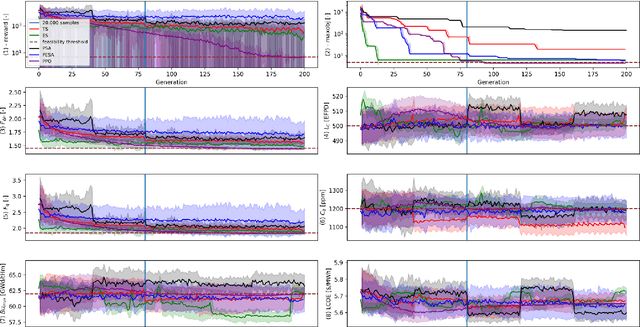



Abstract:The nuclear sector represents the primary source of carbon-free energy in the United States. Nevertheless, existing nuclear power plants face the threat of early shutdowns due to their inability to compete economically against alternatives such as gas power plants. Optimizing the fuel cycle cost through the optimization of core loading patterns is one approach to addressing this lack of competitiveness. However, this optimization task involves multiple objectives and constraints, resulting in a vast number of candidate solutions that cannot be explicitly solved. While stochastic optimization (SO) methodologies are utilized by various nuclear utilities and vendors for fuel cycle reload design, manual design remains the preferred approach. To advance the state-of-the-art in core reload patterns, we have developed methods based on Deep Reinforcement Learning. Previous research has laid the groundwork for this approach and demonstrated its ability to discover high-quality patterns within a reasonable timeframe. However, there is a need for comparison against legacy methods to demonstrate its utility in a single-objective setting. While RL methods have shown superiority in multi-objective settings, they have not yet been applied to address the competitiveness issue effectively. In this paper, we rigorously compare our RL-based approach against the most commonly used SO-based methods, namely Genetic Algorithm (GA), Simulated Annealing (SA), and Tabu Search (TS). Subsequently, we introduce a new hybrid paradigm to devise innovative designs, resulting in economic gains ranging from 2.8 to 3.3 million dollars per year per plant. This development leverages interpretable AI, enabling improved algorithmic efficiency by making black-box optimizations interpretable. Future work will focus on scaling this method to address a broader range of core designs.
Pareto Envelope Augmented with Reinforcement Learning: Multi-objective reinforcement learning-based approach for Large-Scale Constrained Pressurized Water Reactor optimization
Dec 19, 2023



Abstract:A novel method, the Pareto Envelope Augmented with Reinforcement Learning (PEARL), has been developed to address the challenges posed by multi-objective problems, particularly in the field of engineering where the evaluation of candidate solutions can be time-consuming. PEARL distinguishes itself from traditional policy-based multi-objective Reinforcement Learning methods by learning a single policy, eliminating the need for multiple neural networks to independently solve simpler sub-problems. Several versions inspired from deep learning and evolutionary techniques have been crafted, catering to both unconstrained and constrained problem domains. Curriculum Learning is harnessed to effectively manage constraints in these versions. PEARL's performance is first evaluated on classical multi-objective benchmarks. Additionally, it is tested on two practical PWR core Loading Pattern optimization problems to showcase its real-world applicability. The first problem involves optimizing the Cycle length and the rod-integrated peaking factor as the primary objectives, while the second problem incorporates the mean average enrichment as an additional objective. Furthermore, PEARL addresses three types of constraints related to boron concentration, peak pin burnup, and peak pin power. The results are systematically compared against a conventional approach, the Non-dominated Sorting Genetic Algorithm. Notably, PEARL, specifically the PEARL-NdS variant, efficiently uncovers a Pareto front without necessitating additional efforts from the algorithm designer, as opposed to a single optimization with scaled objectives. It also outperforms the classical approach across multiple performance metrics, including the Hyper-volume.
Assessment of Reinforcement Learning Algorithms for Nuclear Power Plant Fuel Optimization
May 09, 2023



Abstract:The nuclear fuel loading pattern optimization problem has been studied since the dawn of the commercial nuclear energy industry. It is characterized by multiple objectives and constraints, with a very high number of candidate patterns, which makes it impossible to solve explicitly. Stochastic optimization methodologies are used by different nuclear utilities and vendors to perform fuel cycle reload design. Nevertheless, hand-designed solutions continue to be the prevalent method in the industry. To improve the state-of-the-art core reload patterns, we aim to create a method as scalable as possible, that agrees with the designer's goal of performance and safety. To help in this task Deep Reinforcement Learning (RL), in particular, Proximal Policy Optimization is leveraged. RL has recently experienced a strong impetus from its successes applied to games. This paper lays out the foundation of this method and proposes to study the behavior of several hyper-parameters that influence the RL algorithm via a multi-measure approach helped with statistical tests. The algorithm is highly dependent on multiple factors such as the shape of the objective function derived for the core design that behaves as a fudge factor that affects the stability of the learning. But also an exploration/exploitation trade-off that manifests through different parameters such as the number of loading patterns seen by the agents per episode, the number of samples collected before a policy update, and an entropy factor that increases the randomness of the policy trained. Experimental results also demonstrate the effectiveness of the method in finding high-quality solutions from scratch within a reasonable amount of time. Future work must include applying the algorithms to wide range of applications and comparing them to state-of-the-art implementation of stochastic optimization methods.
NEORL: NeuroEvolution Optimization with Reinforcement Learning
Dec 01, 2021



Abstract:We present an open-source Python framework for NeuroEvolution Optimization with Reinforcement Learning (NEORL) developed at the Massachusetts Institute of Technology. NEORL offers a global optimization interface of state-of-the-art algorithms in the field of evolutionary computation, neural networks through reinforcement learning, and hybrid neuroevolution algorithms. NEORL features diverse set of algorithms, user-friendly interface, parallel computing support, automatic hyperparameter tuning, detailed documentation, and demonstration of applications in mathematical and real-world engineering optimization. NEORL encompasses various optimization problems from combinatorial, continuous, mixed discrete/continuous, to high-dimensional, expensive, and constrained engineering optimization. NEORL is tested in variety of engineering applications relevant to low carbon energy research in addressing solutions to climate change. The examples include nuclear reactor control and fuel cell power production. The results demonstrate NEORL competitiveness against other algorithms and optimization frameworks in the literature, and a potential tool to solve large-scale optimization problems. More examples and benchmarking of NEORL can be found here: https://neorl.readthedocs.io/en/latest/index.html
Machine learning-assisted surrogate construction for full-core fuel performance analysis
Apr 17, 2021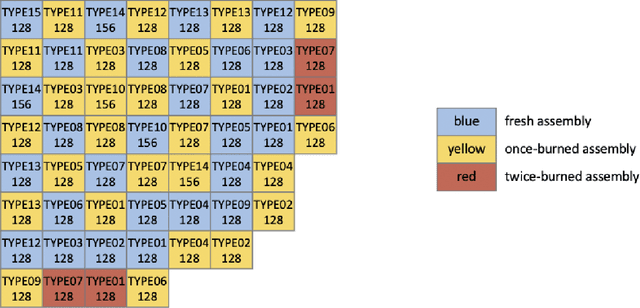
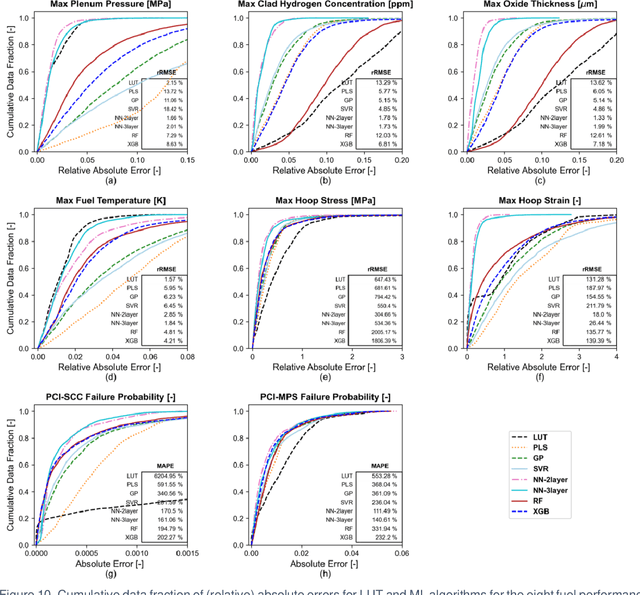
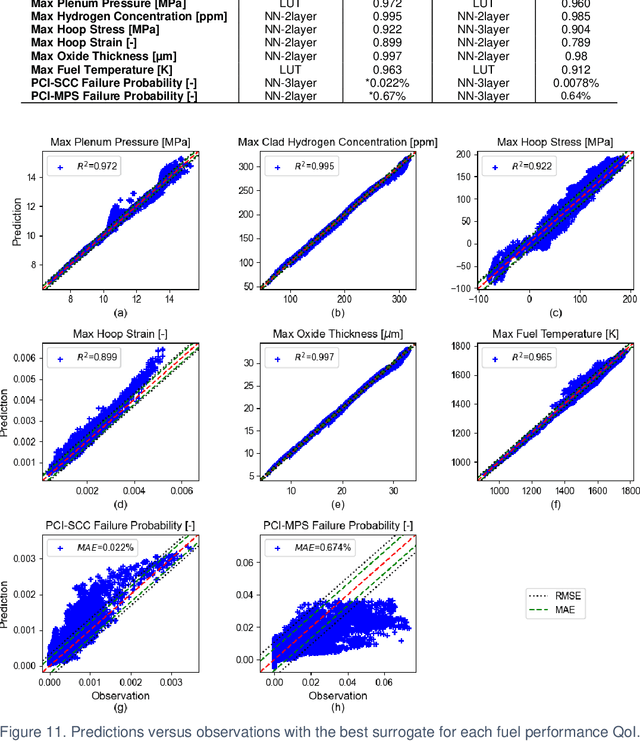
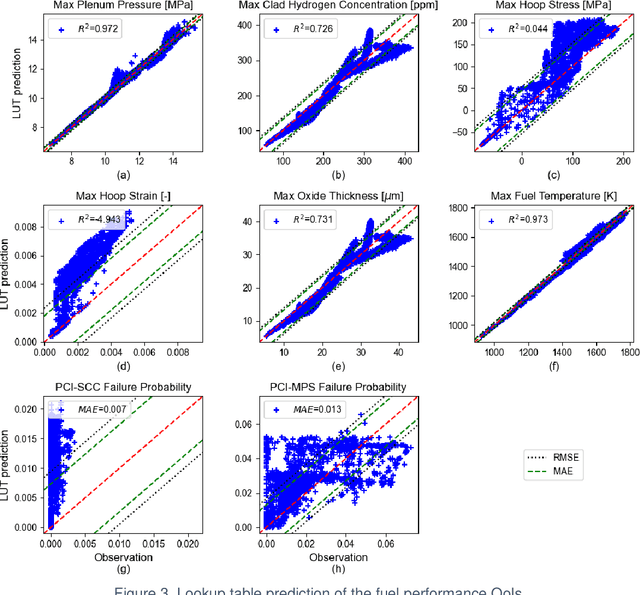
Abstract:Accurately predicting the behavior of a nuclear reactor requires multiphysics simulation of coupled neutronics, thermal-hydraulics and fuel thermo-mechanics. The fuel thermo-mechanical response provides essential information for operational limits and safety analysis. Traditionally, fuel performance analysis is performed standalone, using calculated spatial-temporal power distribution and thermal boundary conditions from the coupled neutronics-thermal-hydraulics simulation as input. Such one-way coupling is result of the high cost induced by the full-core fuel performance analysis, which provides more realistic and accurate prediction of the core-wide response than the "peak rod" analysis. It is therefore desirable to improve the computational efficiency of full-core fuel performance modeling by constructing fast-running surrogate, such that fuel performance modeling can be utilized in the core reload design optimization. This work presents methodologies for full-core surrogate construction based on several realistic equilibrium PWR core designs. As a fast and conventional approach, look-up tables are only effective for certain fuel performance quantities of interest (QoIs). Several representative machine-learning algorithms are introduced to capture the complicated physics for other fuel performance QoIs. Rule-based model is useful as a feature extraction technique to account for the spatial-temporal complexity of operating conditions. Constructed surrogates achieve at least ten thousand time acceleration with satisfying prediction accuracy. Current work lays foundation for tighter coupling of fuel performance modeling into the core design optimization framework. It also sets stage for full-core fuel performance analysis with BISON where the computational cost becomes more burdensome.
 Add to Chrome
Add to Chrome Add to Firefox
Add to Firefox Add to Edge
Add to Edge